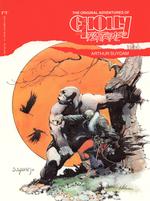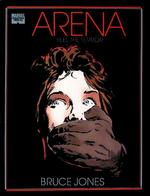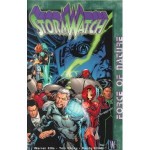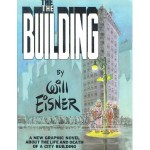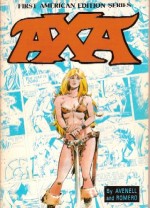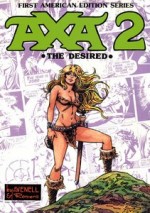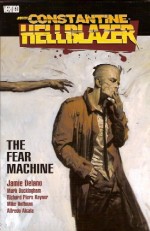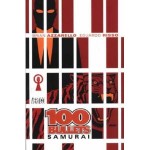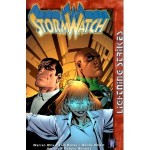
By Warren Ellis, Tom Raney, Jim Lee & various (DC/WildStorm)
ISBN: 978-1-84023-617-0
StormWatch was a paramilitary Special Crisis Intervention unit tasked with managing global threats and superhuman menaces with international ramifications; operating under the oversight of a UN committee. From their “Skywatch†satellite in geosynchronous orbit above Earth they observed, waiting until a member nation called for help…
The multinational taskforce comprised surveillance and intelligence specialists, tech support units, historians, researchers, detention facilities, combat analysts, divisions of uniquely trained troops, a squadron of state-of-the-art out-atmosphere fighter planes and a band of dedicated superheroes for front-line situations beyond the scope of mere mortals. In the pilot’s seat was incorruptible overseer Henry Bendix – “The Weathermanâ€.
StormWatch was born during the comics revolution which saw celebrated young creators abandon major “work-for-hire†publishers to set up their own companies and titles – with all the benefits and drawbacks that entailed. As with most of those glossy, formulaic, style-over-content, almost actionably derivative titles, it started with an honest hectic enthusiasm but soon bogged down for lack of ideas.
Warren Ellis took over the ponderous feature with issue #37 (see the previous collection StormWatch: Force of Nature) and immediately began beating life into the title. Soon “just another high-priced team-book†became an edgy, unmissable treatise on practical heroism and the uses and abuses of power. Making the book unquestionably his plaything Ellis slowly evolved StormWatch out of existence, to be reborn as the no-rules-unbroken landmark The Authority.
StormWatch: Lightning Strikes collects issues #43-47 of the comicbook, taking short, hard looks at individual cast members and also features a spectacular gallery of covers and variant-covers by Tom Raney & Randy Elliot, Mark Irwin, Gil Kane and Jim Lee.
The incisive explorations begin with ‘Jack Hawksmoor’, a human subjected to decades of surgical manipulation by aliens to become the avatar of cities. Drawn to the scene of a serial killer’s grotesque excesses Jack uncovers a festering government cover-up which reaches deep into the soul of America’s most revered idols and threatens to rip the country apart if exposed.
But the apparently untouchable murderer will never cease his slaughter-campaign unless someone stops him…
‘Jenny Sparks’ follows the cynical Englishwoman whose electrical powers were an expression of her metaphysical status as incarnate “Spirit of the Twentieth Centuryâ€: a captivating pastiche of fantasy through the last hundred years as the jaded hero recounts her life story (see also Jenny Sparks: The Secret History of the Authority) in a dazzling series of pastiches referencing Siegel & Shuster, Frank Hampson’s Dan Dare, Kirby, Crumb and the horrors of Thatcherite Britain in a gripping tale of betrayal, whilst the terse thriller ‘Battalion’ sees StormWatch’s normally non-operational, behind-the-scenes trainer fall into a supremacist terror-plot whilst on leave in Alabama and forced to call on skills and abilities he never thought he’d need again…
‘Rose Tattoo’ was a mute and mysterious sexy super psycho-killer recruited by Bendix as a walking ultimate sanction. When her super-powered team-mates go on a hilarious alcoholic bonding exercise she finally shows her true nature in a tale which foreshadows an upcoming crisis for the entire team… and planet.
Following Raney & Randy Elliot’s sterling run of the previous four tales Jim Lee & Richard Bennett illustrate the concluding ‘Assembly’ as Bendix sends his core-team into the very pits of Hell in a bombastic action-packed shocker that acts as a “jumping-on point†for new readers and a reminder of what StormWatch is and does… preparatory to Ellis kicking the props out from under the readership in the next volume…
One again skilfully mixing the traditional with the outrageous these episodes offered a fresh take on the costumed catastrophe genre that energised once-jaded readers and paved the way for the graphic phenomenon of the Authority. Darkly anarchic, funny and frightening these tales celebrate the best of what has gone before whilst kicking in the doors to a bleaker more compelling tomorrow.
© 1996, 1997, 2000 WildStorm Productions, an imprint of DC Comics. All Rights Reserved.

